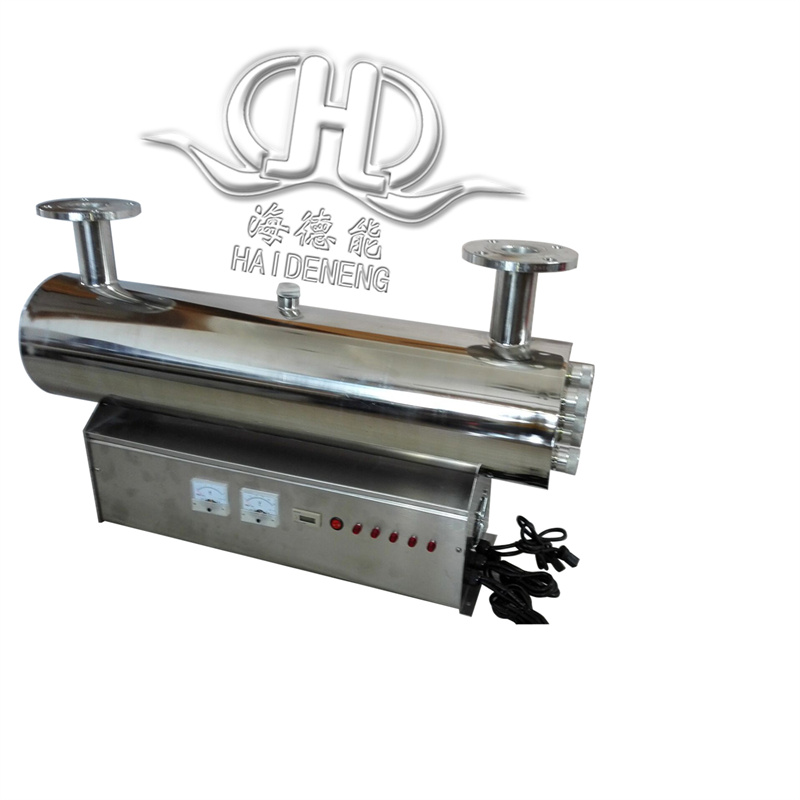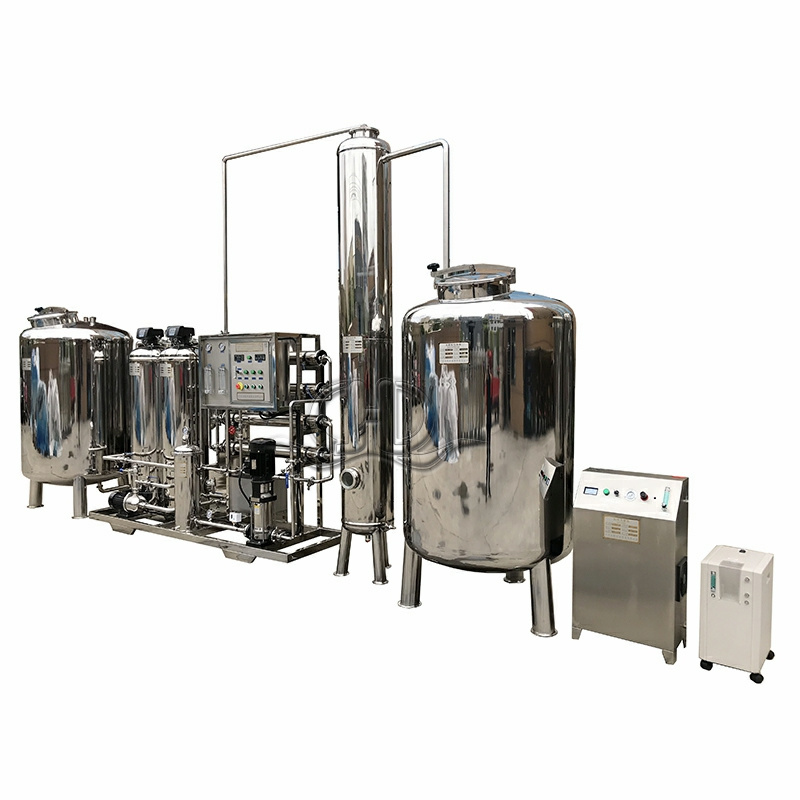Fully automatic two-stage reverse osmosis precision filtration system for reducing salinity in water filtration
Product description
Technical analysis of fully automatic two-stage reverse osmosis precision filtration and salt reduction system
1、 System Core Architecture and Salt Reduction Principle
The fully automatic two-stage reverse osmosis precision filtration desalination system is an efficient desalination technology that uses two-stage reverse osmosis membranes (RO) in series filtration, combined with precision pretreatment, to achieve deep removal of salt from water. The core principle is to use pressure higher than the osmotic pressure to drive water molecules through the semi permeable membrane, while impurities such as salt and organic matter are intercepted. The secondary system further improves the desalination rate through “primary water production and filtration”, which is suitable for high salt water quality (such as seawater, brackish water) and strict desalination scenarios.
2、 System Process Flow and Key Components
plaintext
Raw water → Pre treatment system (sand filtration+carbon filtration+fine filtration) → Primary reverse osmosis (RO1) → Intermediate water tank → Secondary reverse osmosis (RO2) → Precision filtration → Produced water
1. Preprocessing system
Sand filter: removes suspended solids and sediment (turbidity reduced from 20NTU to ≤ 5NTU), commonly using quartz sand (particle size 0.5-1.2mm), with a backwash strength of 15-20L/(m ² · s).
Carbon filter: adsorbs residual chlorine (removal rate>99%) and organic matter, using coconut shell activated carbon (specific surface area ≥ 1000m ²/g) to prevent RO membrane oxidation.
Precision filter: 5 μ m PP filter element, intercepts fine particles, ensures inlet SDI ≤ 5, and protects the RO membrane.
2. First level reverse osmosis (RO1)
Core parameters:
Operating pressure: 1.0-1.6MPa (brackish water) or 6-8MPa (seawater);
Desalination rate: 98% -99%, produced water conductivity ≤ 50 μ S/cm (when raw water TDS<3000mg/L);
Membrane element: Anti pollution polyamide composite membrane (such as Dow SW30HLLE), with a single water production capacity of 25m ³/day.
3. Secondary Reverse Osmosis (RO2)
Key design:
The inflow is RO1 produced water (desalinated), the operating pressure is reduced to 0.5-1.0MPa, and the energy consumption is reduced by 20% -30%;
Using high desalination rate membranes (such as Dow BW30-400), the desalination rate is increased to 99.5% -99.8%, and the conductivity of the produced water is ≤ 1 μ S/cm;
Concentrated water can be refluxed to the inlet of RO1, increasing the overall recovery rate of the system to 80% -90%.
4. Control system
PLC fully automatic operation, real-time monitoring:
Pressure (alarm when the pressure difference before/after the membrane is greater than 0.1MPa);
Conductivity (automatically discharged when RO2 water production exceeds 1 μ S/cm);
Flow rate (adjust the concentrated water valve to control the recovery rate).
3、 Salt reduction effect and water quality indicators
Raw water (seawater) in the treatment stage, RO1 produces water, RO2 produces water
Salt content (TDS) 35000mg/L 350-700mg/L ≤ 35mg/L
Conductivity 50000 μ S/cm 500-1000 μ S/cm ≤ 10 μ S/cm
Desalination rate -98% -99% 99.5% -99.8%
Applicable scenarios: seawater, high salt wastewater industrial water, municipal water supply ultra pure water, pharmaceutical water
4、 Technological advantages and innovative design
Deep salt reduction and high water quality
Secondary RO has a retention rate of over 99.9% for divalent ions (such as Ca ² ⁺, Mg ² ⁺), making it suitable for semiconductor cleaning (ion concentration should be controlled below 1 ppb) and injection water (in accordance with USP standards).
Energy saving and recycling optimization
The energy recovery device (PX pump) recovers the concentrated water pressure of RO1, reducing energy consumption to 3kWh/m ³ (seawater desalination), which is 30% more energy-efficient than traditional single-stage systems;
Concentrated water cascade utilization: RO2 concentrated water flows back to RO1, increasing the total recovery rate from 75% in the single stage to 90% in the second stage, reducing water resource waste.
Anti pollution and long lifespan
Pre treatment of three-stage filtration (sand filtration+carbon filtration+fine filtration) prolongs the RO membrane fouling cycle to more than 12 months;
RO2 has less impurities in the incoming water and a membrane cleaning cycle of 18-24 months, reducing maintenance costs by 50%.
5、 Application Fields
High salinity water treatment
Seawater desalination: water supply for islands and ships (such as the Nansha Islands Seawater Desalination Station, with a water output of 500 tons/day);
Bitter and salty water purification: Convert groundwater (TDS>5000mg/L) in arid areas of Northwest China into drinking water.
High purity water usage scenario
Electronics industry: Ultra pure water (resistivity ≥ 18M Ω· cm) is used for chip manufacturing, requiring a combination of RO2+EDI;
Pharmaceutical industry: Preparation of water for injection (WFI) that meets GMP certification requirements (endotoxin<0.25EU/mL).
Industrial wastewater reuse
Chemical high salt wastewater (such as coal chemical concentrated salt water) is treated by secondary RO, and the produced water is reused for circulating cooling. The concentrated water further evaporates and crystallizes, achieving zero emissions.
6、 Typical case: A seawater desalination project on an island
Raw water: South China Sea seawater (TDS 32000mg/L, hardness 2000mg/L);
System configuration:
plaintext
Seawater → Rotating filter screen → Sand filter+Carbon filter → Fine filter (1 μ m) → RO1 (6.8MPa) → Intermediate water tank → RO2 (1.0MPa) → Pure water tank
Running effect:
Water production: 1000 tons/day, conductivity ≤ 10 μ S/cm;
Energy consumption: 4.2kWh/ton of water (including pre-treatment), cost 8-10 yuan/ton;
System recovery rate: 85% (RO1 75%+SO2 concentrate reflux).
7、 Maintenance and troubleshooting
Analysis of common problem causes and solutions
RO1 water production decreases due to membrane fouling/low inlet water temperature, citric acid cleaning (pH=2.5)/heating up to 25 ℃
RO2 conductivity exceeding standard membrane element leakage/high concentrated water reflux ratio detection membrane shell sealing ring/reducing reflux ratio to 30%
Filter element blockage due to sudden increase in pre-treatment pressure difference/sudden increase in raw water turbidity Replace fine filter element/Increase pre-treatment backwash
8、 Technological development trends
Low pressure and high desalination membrane: Develop ultra-thin composite membranes (desalination layer<300nm) to reduce the operating pressure of RO2 to below 0.3MPa;
Intelligent monitoring: integrating AI algorithms to predict membrane fouling, automatically adjusting operating parameters (such as pressure and recovery rate), and optimizing energy consumption;
Hot film coupling technology: combining two-stage RO with low-temperature multi effect distillation (LT-MED), utilizing industrial waste heat to improve desalination efficiency and reduce comprehensive energy consumption.
This system has irreplaceable advantages in high salt water treatment and high-purity water use through the synergy of two-stage RO deep desalination and precision filtration. With the advancement of membrane technology and the reduction of energy consumption, its application will be expanded to a wider range of industrial and civilian scenarios.







